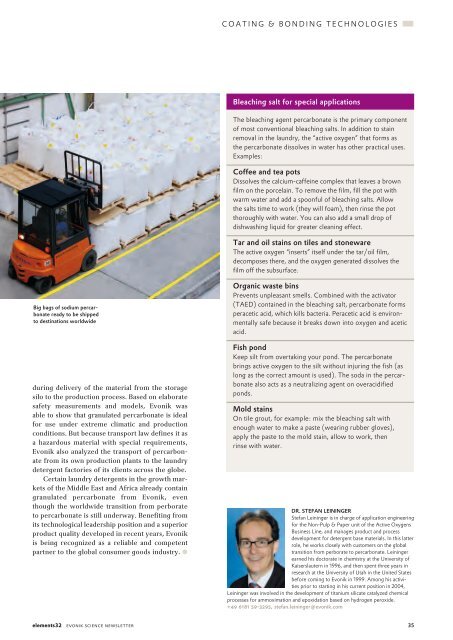Download - Evonik Industries
Download - Evonik Industries
Download - Evonik Industries
You also want an ePaper? Increase the reach of your titles
YUMPU automatically turns print PDFs into web optimized ePapers that Google loves.
Big bags of sodium percarbonate<br />
ready to be shipped<br />
to destinations worldwide<br />
dur ing delivery of the material from the storage<br />
silo to the production process. Based on elaborate<br />
safety measure ments and models, <strong>Evonik</strong> was<br />
able to show that granulated percarbonate is ideal<br />
for use under extreme climatic and production<br />
conditions. But because transport law defines it as<br />
a hazardous material with special requirements,<br />
<strong>Evonik</strong> also analyzed the transport of percarbonate<br />
from its own production plants to the laundry<br />
detergent factories of its clients across the globe.<br />
Certain laundry detergents in the growth markets<br />
of the Middle East and Africa already contain<br />
granulated percarbonate from <strong>Evonik</strong>, even<br />
though the worldwide transition from perborate<br />
to percarbonate is still underway. Benefiting from<br />
its technological leadership position and a superior<br />
product quality developed in recent years, <strong>Evonik</strong><br />
is being recognized as a reliable and competent<br />
partner to the global consumer goods industry. l<br />
elements32 evonik science newsletter<br />
c o A t i n G & B o n D i n G t e c H n o l o G i e S<br />
Bleaching salt for special applications<br />
the bleaching agent percarbonate is the primary component<br />
of most conventional bleaching salts. in addition to stain<br />
removal in the laundry, the “active oxygen” that forms as<br />
the percarbonate dissolves in water has other practical uses.<br />
examples:<br />
Coffee and tea pots<br />
Dissolves the calciumcaffeine complex that leaves a brown<br />
film on the porcelain. to remove the film, fill the pot with<br />
warm water and add a spoonful of bleaching salts. Allow<br />
the salts time to work (they will foam), then rinse the pot<br />
thoroughly with water. You can also add a small drop of<br />
dish washing liquid for greater cleaning effect.<br />
Tar and oil stains on tiles and stoneware<br />
the active oxygen “inserts” itself under the tar/oil film,<br />
decomposes there, and the oxygen generated dissolves the<br />
film off the subsurface.<br />
Organic waste bins<br />
Prevents unpleasant smells. combined with the activator<br />
(tAeD) contained in the bleaching salt, percarbonate forms<br />
peracetic acid, which kills bacteria. Peracetic acid is environmentally<br />
safe because it breaks down into oxygen and acetic<br />
acid.<br />
Fish pond<br />
keep silt from overtaking your pond. the percarbonate<br />
brings active oxygen to the silt without injuring the fish (as<br />
long as the correct amount is used). the soda in the percarbonate<br />
also acts as a neutralizing agent on overacidified<br />
ponds.<br />
Mold stains<br />
on tile grout, for example: mix the bleaching salt with<br />
enough water to make a paste (wearing rubber gloves),<br />
apply the paste to the mold stain, allow to work, then<br />
rinse with water.<br />
DR. STEFAN LEININGER<br />
Stefan leininger is in charge of application engineering<br />
for the nonPulp & Paper unit of the Active oxygens<br />
Business line, and manages product and process<br />
development for detergent base materials. in this latter<br />
role, he works closely with customers on the global<br />
transition from perborate to percarbonate. leininger<br />
earned his doctorate in chemistry at the University of<br />
kaiserslautern in 1996, and then spent three years in<br />
research at the University of Utah in the United States<br />
before coming to evonik in 1999. Among his activities<br />
prior to starting in his current position in 2004,<br />
leininger was involved in the development of titanium silicate catalyzed chemical<br />
processes for ammoximation and epoxidation based on hydrogen peroxide.<br />
+49 6181 59-3295, stefan.leininger@evonik.com<br />
35

















